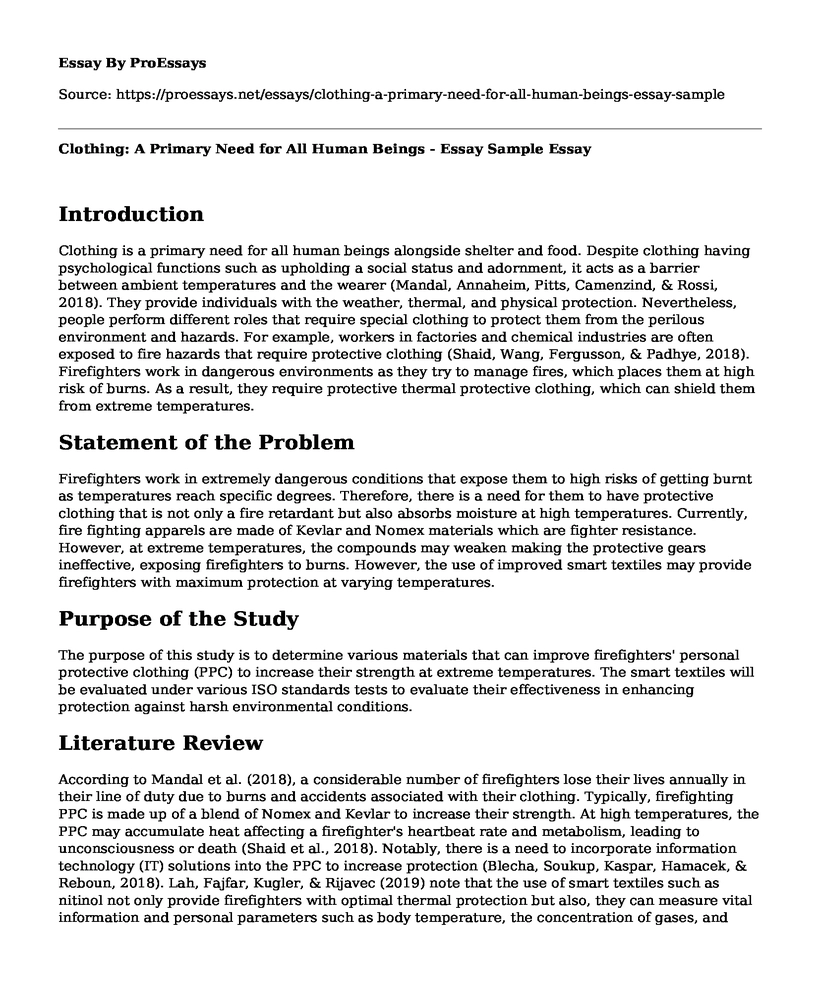Introduction
Clothing is a primary need for all human beings alongside shelter and food. Despite clothing having psychological functions such as upholding a social status and adornment, it acts as a barrier between ambient temperatures and the wearer (Mandal, Annaheim, Pitts, Camenzind, & Rossi, 2018). They provide individuals with the weather, thermal, and physical protection. Nevertheless, people perform different roles that require special clothing to protect them from the perilous environment and hazards. For example, workers in factories and chemical industries are often exposed to fire hazards that require protective clothing (Shaid, Wang, Fergusson, & Padhye, 2018). Firefighters work in dangerous environments as they try to manage fires, which places them at high risk of burns. As a result, they require protective thermal protective clothing, which can shield them from extreme temperatures.
Statement of the Problem
Firefighters work in extremely dangerous conditions that expose them to high risks of getting burnt as temperatures reach specific degrees. Therefore, there is a need for them to have protective clothing that is not only a fire retardant but also absorbs moisture at high temperatures. Currently, fire fighting apparels are made of Kevlar and Nomex materials which are fighter resistance. However, at extreme temperatures, the compounds may weaken making the protective gears ineffective, exposing firefighters to burns. However, the use of improved smart textiles may provide firefighters with maximum protection at varying temperatures.
Purpose of the Study
The purpose of this study is to determine various materials that can improve firefighters' personal protective clothing (PPC) to increase their strength at extreme temperatures. The smart textiles will be evaluated under various ISO standards tests to evaluate their effectiveness in enhancing protection against harsh environmental conditions.
Literature Review
According to Mandal et al. (2018), a considerable number of firefighters lose their lives annually in their line of duty due to burns and accidents associated with their clothing. Typically, firefighting PPC is made up of a blend of Nomex and Kevlar to increase their strength. At high temperatures, the PPC may accumulate heat affecting a firefighter's heartbeat rate and metabolism, leading to unconsciousness or death (Shaid et al., 2018). Notably, there is a need to incorporate information technology (IT) solutions into the PPC to increase protection (Blecha, Soukup, Kaspar, Hamacek, & Reboun, 2018). Lah, Fajfar, Kugler, & Rijavec (2019) note that the use of smart textiles such as nitinol not only provide firefighters with optimal thermal protection but also, they can measure vital information and personal parameters such as body temperature, the concentration of gases, and heart rate. The improved features reduce accidents, giving firefighters a bit of freedom in their work. Jin et al. (2018) also claim that smart textiles can absorb moisture, which cools the PPCs.
Research Question
Does the use of smart fabric such as nitinol in the firefighters PPE improve thermal insulation in higher temperatures above 100 0C?
Can the use of smart fabrics facilitate optimal moisture absorption at high temperatures and prevent burns?
Hypothesis
Null hypothesis: Quilting smart fabrics into PPCs will not improve their thermal index. Additionally, it is hypothesized that smart textiles will not facilitate absorption moisture at elevated temperatures
Alternative hypothesis; incorporating a layer of nitinol fabric into firefighting PPC will increase its thermal insulation index
Research Methodology
The study will utilize a quantitative research design to investigate how different smart textiles improve the thermal insulation of firefighting apparel. Experiments will be conducted to test each fabric's radiant heat transfer, heat transfer index, total heat loss, and anti-heat stress. The results will be compared to the values of normal PPCs to identify if there is any considerable improvement.
References
Blecha, T., Soukup, R., Kaspar, P., Hamacek, A., & Reboun, J. (2018). Smart textile-based protective system for firefighters. Proceedings of the 5th Electronics System Integration Technology Conference (ESTC). DOI: 10.1109/ESTC.2014.6962821
Jin, L., Cao, M. L., Yu, W., Hu, J. Y., Yoon, K. J., Park, P. K., & Li, Y. (2018). New approaches to evaluate the performance of firefighter protective clothing materials. Fire Technology, 54(5), 1283-1307. Retrieved from https://link.springer.com/article/10.1007/s10694-018-0730-2
Lah, A. S., Fajfar, P., Kugler, G., & Rijavec, T. (2019). A NiTi alloy weft knitted fabric for smart firefighting clothing. Smart Materials and Structures, 28(6), 065014. Retrieved from https://iopscience.iop.org/article/10.1088/1361-665X/ab18b9
Mandal, S., Annaheim, S., Pitts, T., Camenzind, M., & Rossi, R. M. (2018). Studies of the thermal protective performance of fabrics under fire exposure: from small-scale to hexagon tests. Textile Research Journal, 88(20), 2339-2352. https://doi.org/10.1177/0040517517723020
Shaid, A., Wang, L., Fergusson, S. M., & Padhye, R. (2018). Effect of Aerogel Incorporation in PCM-Containing Thermal Liner of Firefighting Garment. Clothing and Textiles Research Journal, 36(3), 151-164. https://doi.org/10.1177/0887302X18755464
Cite this page
Clothing: A Primary Need for All Human Beings - Essay Sample. (2023, Mar 24). Retrieved from https://proessays.net/essays/clothing-a-primary-need-for-all-human-beings-essay-sample
If you are the original author of this essay and no longer wish to have it published on the ProEssays website, please click below to request its removal:
- Analyzing Bullying Through Literature: Thirteen Reasons Why Essay
- Analysis of the "Outsourced" Movie - Essay Sample
- Akan Music: Traditional Sounds From West Africa - Essay Sample
- Essay Example on Gyaru: Japan's Wild Fashion Subculture for Two Decades
- Essay Example on Bikers Gang Subculture: A Product of Postmodernism
- Essay Sample on My Life as a Zucchini: The Journey of Icare After Losing His Mom
- Free Essay Sample on How Social Media Can Affect Women's Mental and Physical Health







